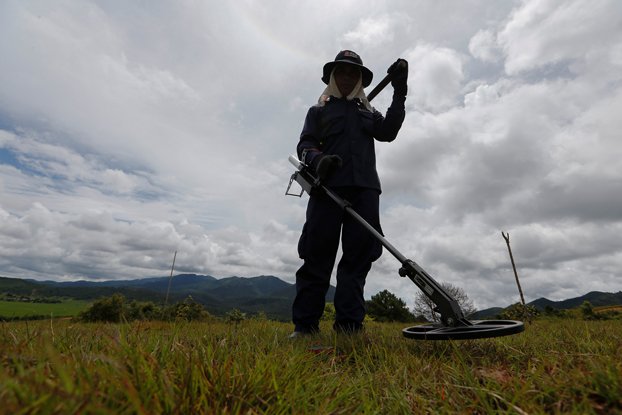
The years-long process of clearing unexploded bombs dropped on Laos by U.S. bombers during the Vietnam War has run out of funding, and workers say they are not getting paid for their labor.
Laos is the most heavily bombed country per capita in the world, with an estimated 80 million unexploded ordnance, or UXO, still scattered nationwide with a heavy concentration in the southern part of the country.
Bomb remnants have stymied the country’s development with the majority of Laos’ roughly 7.5 million people living on UXO-contaminated land and vulnerable to deadly explosions from what they refer to as “bombies” — unexploded tennis ball-sized submunitions from the cluster bombs found in shallow dirt, between tree branches or in the furrows of fields.
Foreign funding from the Japanese government to remove the bombs ran out a year ago, said an official from Sekong province who like other sources declined to be identified because he is not authorized to speak to the media.
Workers in three southern provinces – Saravane, Sekong and Champassak – say they haven’t been paid since last May.
An employee in Sekong province said he and his colleagues have been working without pay while waiting for their salaries, performing mostly office work, taking care of equipment and working with their central office and villagers who have problems with the unexploded bombs and need advice.
Although an agreement is in place for the next phase, the money has not been received yet, he said.
“If we get it, we will use it for administration costs and salaries for employees who didn’t get paid,” he told Radio Free Asia. “Some of the workers are still employed and waiting for back pay, but others have quit and found new jobs to support their families, he added.
Only 1% cleared
Roughly 30% of Laos is contaminated with unexploded ordnance. Only 1% has been cleared since the last bomb was dropped in 1973, according to the New York-based NGO Legacies of War, which advocates for a bomb-free Laos.
Of the 270 million cluster bombs dropped on Laos, approximately 30%, or about 80 million, did not detonate upon impact and remain in the ground, the NGO says.
The Japanese government has provided more than US$14 million to Laos during the past five years to support bomb clearance, education, health, and other development activities, reported Paxason, a Lao weekly state-run newspaper, earlier this month.
Now, the Japanese government has agreed to provide over 800 million yen, or US$6 million, for bomb removal and support local development and poverty reduction in the three southern provinces, the report said
Meanwhile, the three UXO teams in Saravane province ceased operations after the last round of Japanese funding was used up and are still waiting to be paid.
High-ranking officials know that funding ran out and that the UXO workers haven’t been paid in the past year, said a provincial official who declined to be named.
Thong Beuy Sing Khao Pheth, leader of the UXO unit in Saravane, told Lao media last week that the teams cleared only 333 hectares (82 acres) of a targeted area of 337 hectares (91 acres) in the last year, and that some employees have not yet be paid for past work.
“Some employees have not received salaries since January last year after the project closed,” said a UXO employee from the province. “The team leader said we’d have to wait for high-level officials to confirm when we will get paid.”
Translated by Sidney Khotpanya for RFA Lao. Edited by Roseanne Gerin and Malcolm Foster.
